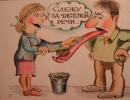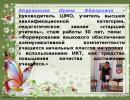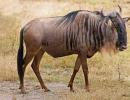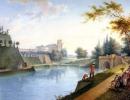What is a natural geographical location? Geographical location of the country. Electronic educational resources
Topic 10. Russia in the global economy
1. Natural-geographical position of Russia and its national wealth.
2. Industry structure and main indicators of the Russian economy.
3. Main problems of the Russian economy.
4. Russia's participation in international organizations.
5. Russia's participation in integration unions in the post-Soviet space.
Russia, officially the Russian Federation or Russia, in practice the abbreviation RF is also used - a state in Eastern Europe and Northern Asia.
Russia is the largest state in the world, occupying 11.5% of the land area - 17,098,246 km² (1st place in the world).
The population as of 2012 is 143,030,106 people (9th place in the world).
The capital is Moscow (10.5 million people).
National language - Russian.
The head of state is the president.
Legislative body: bicameral Federal Assembly (State Duma and Federation Council).
Russia is a mixed republic with a federal structure. It is divided into 83 administrative-territorial units, 46 of which are regions, 21 are republics, nine are territories, two are federal cities, four are autonomous okrugs and one is an autonomous region.
Russia borders with eighteen countries (the largest number in the world), including two partially recognized ones, of which by land with the following states: Norway, Finland, Estonia, Latvia, Lithuania, Poland, Belarus, Ukraine, Abkhazia, Georgia, South Ossetia, Azerbaijan , Kazakhstan, China, Mongolia, North Korea.
Russia is one of the most water-rich countries in the world. The country has some of the world's largest fresh water reserves. Surface waters occupy 12.4% of Russia's territory, with 84% of surface waters concentrated east of the Urals; Many densely populated areas of the European part of Russia experience a shortage of water resources. The structure of water use is dominated by industrial needs.
The largest freshwater lake is Baikal in the eastern part of the country (about 31,700 km²), which is the deepest lake on the planet.
The country is rich in various minerals. Russia has the world's largest proven natural gas reserves and is also its largest producer. In addition, Russia shares first and second place in terms of the volume of oil produced, and ranks second in terms of the volume of its exports. Large coal deposits are found in the Komi Republic, Eastern Siberia and the Far East. Russia is also rich in iron ore, nickel, tin, gold, diamonds, platinum, lead, and zinc. Many of these resources are located in Siberia, where long distances, sparse populations, harsh climate and permafrost pose significant challenges to economically extracting and transporting raw materials to places of processing and consumption.
Russia is an industrial country with a dynamically developing economy. The GDP volume for 2011 amounted to 2.376 trillion US dollars (about 16,700 US dollars per capita). The monetary unit is the Russian ruble (the average exchange rate for 2011 is 29.4 rubles per 1 US dollar).
The Russian economy ranks 6th in the world in terms of GDP in PPP terms (for 2011). According to 2007 data, the share of the Russian economy in the world economy is 3.2%.
Geographical position
Türkiye is located in the eastern hemisphere, between 25o 40/ and 44o 48/ east. 35o 51/ and 42o 06/ N. Its area (including internal reservoirs) is 779,452 sq. km. The bulk of Turkey's territory - 97% - is located in Asia and only 3% in Europe. The geographical feature of Turkey is its location at the crossroads of important routes that since ancient times have connected Europe with Asia, the Black Sea countries and peoples with the Mediterranean ones. Nowadays, highways and railways run through the territory of Turkey, connecting Europe with many Asian countries. The maximum length of Turkish territory from west to east is 1600 km, from north to south 600 km. Those. on three sides, it is washed by seas: in the north by the Black Sea, in the west by the Aegean, in the south by the Mediterranean. The European and Asian parts of Turkey are separated from each other by a water system that forms a sea passage from the Black Sea to the Aegean and includes the Sea of Marmara, the Bosphorus and the Dardanelles. In the southern part of the Bosphorus and the Golden Horn of Marmara, one of the most beautiful cities in the world and the largest city in Turkey is located - Istanbul.
Natural and ecological conditions of the territory
Türkiye is a mountainous country. The average height of its territory above sea level is 1132 m. Almost the entire territory of Asian Turkey is occupied by the Asia Minor Plateau, which includes high mountain ranges, dissected by specific units and crowned with powerful peaks, and vast dry highlands and plateaus. There are few low-lying plains in the country; they are located on separate sections of the sea coasts, usually at river mouths.
MINERALS
There are more than 100 types of minerals in Turkey. The country has many types of ore, mining, chemical, fuel and energy raw materials. First of all, it should be mentioned - chrome, tungsten, copper ores, borates, marble, coal, etc. Turkey accounts for 25% of the world's mercury reserves. Turkey has huge fuel and energy resources - oil, uranium, brown coal, hard coal. The following rocks occur in Turkey: asbestos, marble, borates, sulfur.
The territory of Turkey is located within the Mediterranean subtropical climate zone. However, the mountainous, highly dissected terrain, very difficult air circulation conditions, and the presence of climatic zones - all this determined a wide variety of climatic regions. The climate in the interior highlands is continental. Precipitation prevails in the steppe up to 500 mm per year.
RIVER SYSTEM AND LAKES
The territory of Turkey, with the exception of the Canian Plain, is covered with a dense river network. But all the rivers are mountainous in nature, abound in waterfalls, rapids and are therefore not navigable. The high speed of the current makes them almost non-freezing, even in high mountain areas. Main rivers: Euphrates (2800 km), Tigris (1900 km), Kyzyl-Irmak (1355 km), Sakarya (824 km).
About 9.2 thousand sq. km. The areas of Turkey are occupied by lakes: Crater, karst, lagoonal, tectonic, dammed-volcanic. The largest are Van (3713 sq. km.) - salty, drainless, Tuz (1500 sq. km.) - salty.
VEGETATION AND ANIMAL WORLD
With about 6,700 plant species, Turkey's flora is rich and varied. Two large plant zones can be distinguished - coastal and inland. The coastal part of the coastal zone is mainly a cultural strip, i.e. arable lands, gardens, vegetable gardens. Behind it comes an area of forests and bushes.
The fauna of Turkey is characterized by an abundance of desert-steppe and mountain species. In the mountain forests one can find red deer, fallow deer, roe deer, wild boar, leopard, bear, and badger. The treeless mountains are characterized by the bezoar goat and mouflon. Steppe lynx and jackals live on the plateaus. Such widespread animal species as the wolf, fox, and hare have local subspecies in Asia Minor. There are many steppe rodents and reptiles.
The typic world is very diverse. Large birds of prey include eagles, vultures, sarash, kites, and hawks. There are white aletas. Blackbirds, woodpeckers, cuckoos, larks, tits, swallows. Cranes, herons, geese, ducks, lapwings, gulls.
The ichthyofauna is represented by a wide variety of fish species living in the sea basins of Turkey. These are mainly mullet, mackerel, herring, sturgeon, etc.
The natural and economic region of Central Russia is called so not by location, but for historical reasons. The Russian centralized state was born here and the capital of Russia, Moscow, is located here.
Standard plan for characterizing the area
- Composition of the region.
- Physical and economic-geographical position of the region.
- Features of nature and natural resources of the region.
- History of the development of the territory and the formation of the economic complex.
- Population and labor resources.
- Farming.
- Territorial structure of settlement and economy.
- Main problems and prospects.
The area of Central Russia is more than 900 thousand km² or 5% of the territory of Russia.
- The region includes three large subdistricts: Central, Central Chernozemny, Volgo-Vyatka.
- These are 19 regions (Bryansk, Vladimir, Ivanovo, Kaluga, Kostroma, Moscow, Oryol, Ryazan, Smolensk, Tver, Tula, Yaroslavl, as well as Kirov and Nizhny Novgorod, Belgorod, Voronezh, Kursk, Lipetsk, Tambov), 3 republics (Mari El , Mordovia and Chuvash Republic) and the city of Moscow.
Economic-geographical location- this is the position of an object in relation to other objects of economic importance.
1. First of all, let's consider the position of the region on the territory of the state. To do this, we will use the administrative map of Russia. The map shows that Central Russia is located in the west of the country and occupies a border position. Its western borders lie along the state border of Russia.
2. The economic environment of the region consists of: Ukraine and the Republic of Belarus, with which Central Russia borders in the west. In the northwest, northeast and south, Central Russia's neighbors are other economic regions. In the north and north-west there are the Northern and North-Western natural-economic regions, in the east the Volga and Ural regions, in the south the North Caucasus region.
3. Central Russia is well located in relation to the country’s large fuel, energy and raw material bases. On the territory of the Northern region there are large reserves of coal, oil, gas, iron ores, non-ferrous metal ores and apatites. The Volga region has large oil reserves, the Urals has ferrous and non-ferrous metal ores, salts, and natural gas; the North Caucasus region has reserves of tungsten-molybdenum and lead-zinc ores. Oil and gas deposits are located in the sedimentary rocks of the Ciscaucasia trough.
4. Central Russia also has a convenient transport and geographical location, that is, a position on transport routes connecting the territory with the main sources of raw materials, energy, food, and sales markets. The region is located at the intersection of major transport routes. These are oil pipelines, gas pipelines, railways and roads. The main waterway of Russia runs from north to south along the Volga River (Fig. 1).
Rice. 1. Single waterway
The only drawback is the lack of access to the sea.
5. The EGP of a territory changes over time. This is mainly due to economic changes that are taking place in neighboring territories. Over time, EGP may improve or worsen.
Having examined the EGP of Central Russia, we will draw a conclusion. The EGP of the region is beneficial and contributes to the economic development of the region, since the region occupies a central position, the capital of Russia is located on its territory, it has good transport connectivity, and the territories neighboring the region have large reserves of natural resources.
Central Russia is located in the center of the East European Plain, so flat terrain prevails here. Lowlands alternate with hills.
The climate is temperate, temperate continental with relatively mild winters and warm summers. The amount of precipitation is from 400 to 600 mm, the average temperatures in January are -10°... -12°, in July - +17°...+18°.
Very cold winters are typical only for the Volga-Vyatka region (Fig. 2); droughts often occur in the southeast of the region, and the northeastern part of the region is waterlogged and swampy.

Rice. 2. Winter
The richest soils, chernozem soils (Fig. 3), are located in the Central Chernozem region, but in most of the region soddy-podzolic soils predominate, and gray forest soils are often found. These types of soils have fairly high fertility and, in combination with the climate, create conditions for the development of agriculture.

Rice. 3. Chernozem soils
Most of the region is in the mixed forest zone, with broad-leaved forests and forest-steppes in the south, and taiga in the northeast.
But the availability of forest resources, especially per capita, is low.
Central Russia is not rich in mineral resources. The northeastern part is part of the Volga-Ural oil and gas basin, but production volumes here are insignificant. The main resources of the region are concentrated in the Central Black Earth region: KMA iron ore reserves (60% of Russia's iron ore raw materials) and very large deposits of limestone and raw materials for cement production. The region has deposits of brown coal, peat, phosphorites, and mineral and construction raw materials. But most of the raw materials needed by the region are imported from other states and regions of the country.
The region's recreational resources are diverse, but not yet fully developed.
The main types of recreational activities in the region include:
- Excursions and tourism
- Spa treatment
- Organization of recreational areas for the population
In Central Russia there are 12 state nature reserves, 2 biosphere reserves (Central Black Earth and Voronezh), 9 national parks. Here conditions are created for the preservation of natural landscapes (Fig. 4).

Rice. 4. Voronezh Nature Reserve: muskrat
The long history of the Russian state is captured in numerous cultural and historical monuments. A number of cultural and historical sites are included in the list of world natural and cultural heritage sites: Red Square and the Moscow Kremlin, monuments of the Vladimir-Suzdal land (Fig. 5). Many cities combine historical, cultural and natural landscape attractions.

Rice. 5. Suzdal
Bibliography
Main
- Customs E.A. Geography of Russia: economy and regions: 9th grade, textbook for students of general education institutions. - M.: Ventana-Graf, 2011.
- Fromberg A.E. Economic and social geography. - 2011, 416 p.
- Atlas of economic geography, grade 9. - Bustard, 2012.
- Geography. The entire school curriculum in diagrams and tables. - 2007, 127 p.
- Geography. School Student's Handbook. Comp. Mayorova T.A. - 1996, 576 p.
- Cheat sheet on economic geography. Schoolchildren, applicants. - 2003, 96 p.
Additional
- Gladky Yu.N., Dobroskok V.A., Semenov S.P. Economic geography of Russia: Textbook - M.: Gardariki, 2000 - 752 pp.: ill.
- Rodionova I.A., Textbook on geography. Economic geography of Russia. - M.: Moscow Lyceum, 2001. - 189 p.
- Smetanin S.I., Konotopov M.V. History of ferrous metallurgy in Russia. - M.: “Paleotype”, 2002.
- Economic and social geography of Russia: Textbook for universities/Ed. prof. A.T. Khrushchev. - M.: Bustard, 2001. - 672 p.: ill., map.: color. on
Encyclopedias, dictionaries, reference books and statistical collections
- Geography of Russia. Encyclopedic Dictionary/Ch. ed. A.P. Gorkin. - M.: Bol. Ross. enc., 1998. - 800 pp.: ill., maps.
- Russian statistical yearbook. 2011: Statistical collection/Goskomstat of Russia. - M., 2002. - 690 p.
- Russia in numbers. 2011: Brief statistical collection/Goskomstat of Russia. - M., 2003. - 398 p.
Literature for preparing for the State Exam and the Unified State Exam
- GIA-2013. Geography: standard exam options: 10 options / Ed. EM. Ambartsumova. - M.: “National Education”, 2012. - (GIA-2013. FIPI - school)
- GIA-2013. Geography: thematic and standard exam options: 25 options / Ed. EM. Ambartsumova. - M.: “National Education”, 2012. - (GIA-2013. FIPI - school)
- GIA-2013. Exam in a new form. Geography. 9th grade/FIPI authors-compilers: E.M. Ambartsumova, S.E. Dyukova. - M.: Astrel, 2012.
- Excellent student in the Unified State Exam. Geography. Solving complex problems/FIPI authors-compilers: Ambartsumova E.M., Dyukova S.E., Pyatunin V.B. - M.: Intellect-Center, 2012.
Electronic educational resources
- Educational multimedia manual 1 C Educational collection Geography of Russia. Economy and regions 9th grade
- Multimedia educational manual “Geography lessons from Cyril and Methodius. 8th and 9th grade"
- Russian Geographical Society ().
- Wildlife of Russia. Caucasus ().
- Wildlife of Russia. Ural ().
- Wildlife of Russia. Pristine valleys ().
- I. Epishin In the upper reaches of the Volga (N4/2012)
- E. Chervyakova In the Volga delta (N3/2011)
The ancient Greeks used the word “Mesopotamia” (Interfluve) to designate the lands lying between the Tigris and Euphrates. In fact, however, the Tigris and Euphrates are not the boundaries of this region in the strict sense of the word, but rather the main landmarks towards which its real boundaries gravitate. Using the name “Mesopotamia,” ancient authors wanted to emphasize that the vast majority of this territory lies between two rivers. Mesopotamia is a flat plain in the Tigris-Euphrates basin, stretching northwest from the Persian Gulf to the Upper Euphrates and the mountains of Eastern Anatolia. Now the territory of Mesopotamia is mainly part of Iraq. This entire vast region was divided into Lower and Upper Mesopotamia.
In Upper (Northern) Mesopotamia, the Tigris and Euphrates are far apart. Lower (Southern) Mesopotamia lay in the lower reaches of the Tigris and Euphrates, where these rivers flowed close to each other. Now Tiger and Ev-
when they flow into the Persian Gulf, they merge into
single river Shatt al-Arab; in ancient times they had separate mouths. The Euphrates within Lower Mesopotamia was divided into several branches; their valleys were completely inhabited.
In ancient times, Lower Mesopotamia was called Sumer and, in turn, was divided into southern and northern parts. The south of Lower Mesopotamia was called Primorye, or Sumer in the narrow sense of the word, and the north was initially called Ki-Uri, and later Akkad (after the name of the city of Akkad, the capital of Mesopotamia at the end of the 3rd millennium BC). Hence the name of Lower Mesopotamia as a whole, which was established from the end of the 3rd millennium BC. e., “Sumer and Akkad.” Even later, Lower Mesopotamia began to be called Babylonia, after its new main center - Babylon.
By the middle of the 1st millennium BC. e. Lower Mesopotamia became known as Babylonia, and Upper Mesopotamia became Assyria. Both of these names were also used by Greek scientists, but at the same time they often called Assyria the lands lying west of the Euphrates to the Mediterranean Sea. Within the territory of this "extended" Assyria, geographers needed to distinguish between the part lying west of the Euphrates and the part lying east of it. Greek geographers began to call the first of these parts Syria (a reduced version of the name Assyria), and the second - Mesopotamia.
Thus, the original name of Mesopota is
Mia applied only to Upper Mesopotamia. In addition, in the Hebrew language there was the name Naharaim, literally “The Country of Two Rivers” (Russian synonym - Dvurechye). This is what the ancient Jews called Upper Mesopotamia. The Greek “Mesopotamia” (Mesopotamia) corresponded to the biblical “Nakharaim” (Mesopotamia). Finally, at the beginning of our era, Roman geographers extended the name Mesopotamia to Babylonia (Lower Mesopotamia). This is how the modern geographical concept of “Mesopotamia” arose.
The ambiguity of the name Mesopotamia and its analogues sometimes affects us to this day. For example, where the name Naharaim appears in the Bible, it is translated into European languages as Mesopotamia, although in the Bible only Upper Mesopotamia is called Naharaim, and the name Mesopotamia in modern European languages means both Upper Mesopotamia and Lower Mesopotamia. Similarly, the modern Russian name Mesopotamia, being a tracing from the Hebrew “Na-haraim”, also refers to all of Mesopotamia, and not just to Upper.
Scientists of the 19th–20th centuries. it was believed that the Persian Gulf in ancient times jutted into the coastline much further north than it does now. This point of view is reflected by most maps and atlases of the Ancient East. Valid
but, Sumerian Ur and Eredu, now far removed from
seas, in ancient times were port cities where sea vessels unloaded. However, geologists have found that in fact the boundaries of the bay itself have been
And to this day have remained practically unchanged, and only the mouth of the Tigris and Euphrates rivers was very wide and ran in such a way that ships from the Persian Gulf could easily rise to the river piers in Ur and Eredu. In addition, the depression located near Eredu Apparently, in ancient times it was a lake connected to the old bed of the Euphrates by a system of canals. The same channel could also approach Ur.
An area freely connected with the Persian Gulf
The swampy estuaries of the Tigris and Euphrates and the lagoons connected to them were called in ancient times the “Bitter Sea”. Now, after aridization and rising soil caused by the washing of silt by both rivers, this area is the Shatt al-Arab valley.
Geographically, Mesopotamia is a wide, shallow depression bounded by the Arabian Plateau, the hills of Syria and the mountain ranges of the Armenian Taurus and Zagros. The main centers of civilization development were located in Lower Mesopotamia, which was the most favorable part of the entire Fertile Crescent for agriculture, but poor in mineral resources and timber. In addition, large-scale irrigation, which Mesopotamia
people sought to develop as much as possible and without cost
which agriculture was initially impossible here, led to rapid soil salinization and a drop in yield. Eventually, soil salinization and climate aridization led to the desolation of southern Mesopotamia and its largest center, Babylon.
Ancient Mesopotamia
The territory of Upper Mesopotamia was a hilly steppe, in some places turning into low mountains. Assyria was located in the east of Upper Mesopotamia (this name was used by Greek authors and accepted in science to designate
region with its center in the ancient city of Ashur on
Middle Tigre).
One of the main features of the geopolitical map of Mesopotamia is its two permanent “fronts”: in the north - northeast - east of it (where the lowland inhabitants of Mesopotamia interacted with the highlanders - almost always hostile) and on the border with the Arabian plateau (from where the wave of nomads invaded in waves).
The extreme poverty of Mesopotamia in mineral resources, including metals, and wood, stimulated the development of foreign trade and military expansion from an early date. The Mesopotamians exported textiles, grain and handicrafts, and themselves sent trade and military expeditions for timber, metals and slaves.
The need to compensate for the lack of natural resources forced the Mesopotamian rulers to receive appropriate raw materials and products in the form of tribute from the mountainous periphery in the north and east, as well as to establish control over the main trade routes leading west to the Mediterranean Sea. From the middle of the 3rd millennium BC. e. and until the end of the existence of independent Mesopotamian statehood, the rulers of Mesopotamia systematically carried out military campaigns for these purposes to the Mediterranean Sea and to the mountainous regions of Western Iran.






